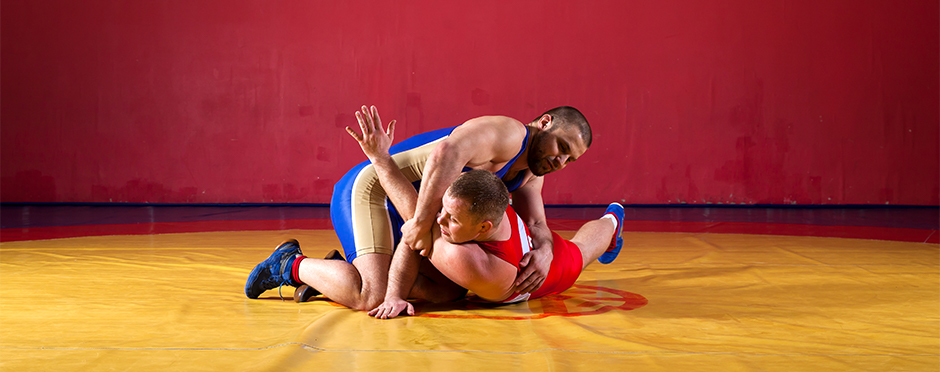
Common Wrestling Injuries and Treatment Options
1 CommentWrestling is one of the world’s oldest sports. Since wrestling season is getting underway, let’s take a quick moment to look at some common injuries that can impact wrestlers:
Knee Injuries
Prepatellar bursitis
- What: Prepatellar bursitis is inflammation of the bursa, which is a fluid filled sac located in front of the kneecap. In wrestling this area is constantly hitting the mat.
- Symptoms: Symptoms of prepatellar bursitis can include sharp pain and swelling of the kneecap area.
- Treatment: Treatment can include anti-inflammatory medications, ice, rest and the use of knee pads by the wrestler.
- Prevention: Wrestlers can wear knee pads to decrease the contact of the knee with the mat, which is aggravating to the bursa.
Knee ligament injuries
- What: Commonly injured knee ligaments in wrestling include the medial collateral ligament (MCL) or lateral collateral ligament (LCL) of the knee, located on the middle and outside of the knee respectively. These injuries can occur in wrestling when the leg is twisted outward from the body.
- Symptoms: Pain, swelling of the knee, difficulty putting full weight on the knee, and pain with bending and straightening the knee are all symptoms of knee ligament injuries.
- Treatment: Treatment of a mild sprain of the ligament can include RICE (rest, ice, compression, and elevation). More severe injuries are treated by a physician, however surgery is rarely indicated. Physical therapy can help recovery and return to sport after a MCL or LCL injury.
- Prevention: Maintaining good strength in both the quads and hamstrings can help strengthen the knee and decrease the risk of injury. Also flexibility of these same muscle groups will help with preventing injury.
Shoulder Injuries
Shoulder Separation
- What: A shoulder separation can occur when a wrestler takes a blow to the shoulder or falls onto the shoulder. The separation is due to ligaments being torn that help the clavicle (collar bone) stay stable with the rest of the shoulder. Usually after this injury the clavicle rests in a higher position.
- Symptoms: A visible step off over the shoulder where the clavicle rests higher is common, as well as pain over that region. A wrestler may also have less movement of the shoulder with overhead reaching.
- Treatment: Shoulder separations have varying severity levels. For minor injuries, physical therapy and taping can be used for treatment. A larger grade separation may require surgery to correct.
- Prevention: Since a separation is typically a traumatic event, it can be difficult to prevent. However if a wrestler has good flexibility and well-balanced strength in the shoulder prior to injury, it can make recovering from an injury easier.
Shoulder Dislocation/Subluxation
- What: Dislocations and subluxations occur when there is an impact to the arm where the arm is rotated and away from the body, causing the joint to separate. In wrestling, this can be a fall onto an outstretched arm.
- Symptoms: If the shoulder goes out but comes back into the joint on its own, that is a subluxation. If the shoulder does not go back on its own, the wrestler needs to see a doctor to have the dislocation corrected. Pain, swelling, and difficulty moving the arm are all common symptoms after these injuries.
- Treatment: Imaging is recommended after this injury to assess for damage to the ligaments and muscles of the shoulder. Physical therapy can help to strengthen muscles and decrease pain after this injury.
- Prevention: If a wrestler is falling, they can try to keep their arms close to the body to prevent the fall onto the outstretched arm.
Neck Injury
Cervical Sprain/Strain
- What: A cervical sprain or strain can occur when there is a sudden fall or impact with the mat or opponent in wrestling. Usually the head is quickly, and possibly forcibly, moved from one position to another.
- Symptoms: The neck muscles may feel like they are in spasm. Difficulty and pain with moving the head and neck are common. Headaches may also occur due to muscle tension.
- Treatment: Heat, ice, anti-inflammatory medications and physical therapy can be used to help decrease the muscle tension and symptoms of a cervical sprain or strain. These treatments can also improve range of movement of the head and neck.
- Prevention: Try to avoid the quick movements into extreme stretched positions of the neck. Warm up prior to a match can include neck stretches to prepare the muscles for the possible movements that can occur during wrestling.
If you are a wrestler who has suffered an injury, schedule a free assessment at a nearby Athletico clinic so our experts can help you recover.
The Athletico blog is an educational resource written by Athletico employees. Athletico bloggers are licensed professionals who abide by the code of ethics outlined by their respective professional associations. The content published in blog posts represents the opinion of the individual author based on their expertise and experience. The content provided in this blog is for informational purposes only, does not constitute medical advice and should not be relied on for making personal health decisions.

1 Comment
Dylan Peterson
It’s helpful to know that a shoulder separation can happen when a blow is taken to the shoulder. My son wants to start wrestling in the fall, and I want to be prepared for any injuries that he might sustain. I’ll be sure to keep this in mind as we prepare for the season